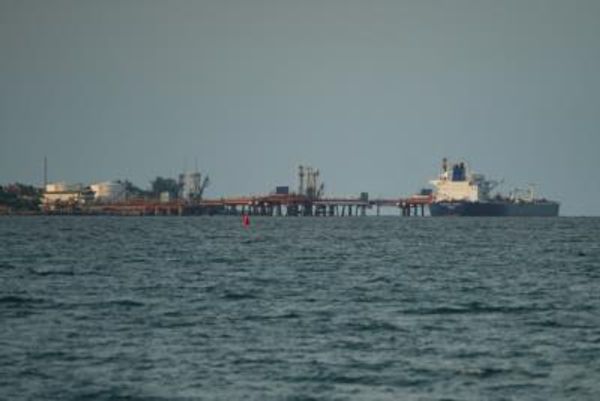Losing money has not stopped Royal Caribbean (RCL) and Carnival Cruise Lines (CCL) from spending to ensure that they have new ships and destinations to keep customers coming back.
Both companies have lost (and continue to lose) billions because of the pandemic, but the two leading U.S. cruise brands understand that surviving, and eventually thriving, requires continued investment.
The U.S. cruise industry fully shut down from March 2020 through July 2021. And that July return was muted, with ships slowly coming back into service while operating at limited capacities.
Even now, both Royal Caribbean and Carnival only have some of their ships in operation (though the majority have returned) and capacity limits remain. That pretty much ensures continued losses (albeit narrower ones), but both companies have found the financial resources to keep making major investments.

Image source: Royal Caribbean.
RCL Adds Wonder of the Seas as Coco Cay Grows
During the pandemic, Royal Caribbean added Odyssey of the Seas, a new ship that was supposed to start sailing out of Israel. That never happened due to political unrest in the Middle East, but the Odyssey did begin sailing out of Florida this past summer.
Now, the cruise line is building Icon of the Seas, the first member of a new class of ships, and it has just taken delivery of Wonder of the Seas, according to a report from the Royal Caribbean Blog (which has no affiliation with the company).
The fifth Oasis Class ship, Wonder will be transferred from the ship's builder to the cruise line on Jan. 27. Royal Caribbean's senior vice president of entertainment, Nick Weir, traveled to the shipyard in Marseille, France, to tour the ship before his company takes possession. He shared the news on Twitter:
"At 236,857 gross tons, Wonder of the Seas is the fifth Oasis Class cruise ship and takes the title from Symphony of the Seas as the biggest in the world," wrote Royal Caribbean Blog's Matt Hochberg. "Wonder of the Seas is 1,188 feet in length and has a maximum passenger capacity of 6,988 passengers, in addition to 2,300 crew."
The new ship will sail out of Fort Lauderdale beginning in March before moving to the Mediterranean.
Royal Caribbean has also begun construction on Hideaway Beach, a new adults-only area of its Coco Cay private island in the Bahamas. While Carnival's private island is basically a beach with some kids' areas, Coco Cay has an added-fee water park, the largest pool in the Caribbean, and a number of areas that make it a destination beyond just a beach day.
Carnival Has a New Ship Coming, Too
New ships generally command higher prices and they get lapsed customers to come back while enticing regulars to spend more.
Carnival hasn't stood pat when it comes to adding new ships with the Mardi Gras joining the fleet last year and Jubilee slated to start sailing in November 2023.
The company has put some of the initial sailings for the third Excel-class ship on sale. Jubilee will call Galveston, Texas, its homeport, offering seven-day Western Caribbean itineraries with stops in Cozumel and Costa Maya, Mexico, as well as Mahogany Bay (Isla Roatan), Honduras.
"Before settling into its new home, Carnival Jubilee will depart on Oct. 30, 2023, from London (Southampton) on an 18-day transatlantic voyage. The ship will visit the Port of Vigo in Spain, Las Palmas and Tenerife in the Canary Islands, Funchal in Portugal, and Grand Turk, before arriving in Texas," the company said in a news release.
Carnival and RCL Have Posted Major Losses
Carnival reported a $7.1 billion loss for 2021 and an $8.8 billion loss for 2020. Those were, of course, pandemic-driven.
Carnival has taken significant action to keep its balance sheet healthy, according to Chief Financial Officer David Bernstein.
"We ended the fiscal year with $9.4 billion of liquidity and have addressed our short-term maturities, improving our future liquidity position," he said in the company's fourth-quarter earnings release.
"Through our debt management efforts, we have refinanced over $9 billion to date, reducing our future annual interest expense by approximately $400 million per year and extending maturities, optimizing our debt maturity profile. During 2022, we will continue to be focused on pursuing refinancing opportunities to reduce interest rates and extend maturities."
Carnival expects to begin deleveraging in 2023.
Royal Caribbean, which has a different fiscal year than Carnival, has lost $2.8 billion through three quarters of 2021. That followed a $3.58 billion loss in the same nine-month period in 2020.
"As of Sept. 30, 2021, the company's liquidity was approximately $4.1 billion, including $3.3 billion in cash and cash equivalents, [$100 million] of undrawn revolving credit facility capacity, and a [$700 million] commitment for a 364-day facility," the company reported in its Q3 earnings release.
"The group continues to take steps to improve its balance sheet and reduce its interest costs. During August we redeemed 40% of the 11.5% senior secured notes and issued senior unsecured notes at 5.5%. These transactions are expected to result in annual interest savings of $51 million."
Royal Caribbean stock has recovered from its pandemic lows, but at $76.08 intraday on Jan. 27, it was still about 20% off its five-year high. Carnival stock has fared worse trading at about 66% below its five-year high.







